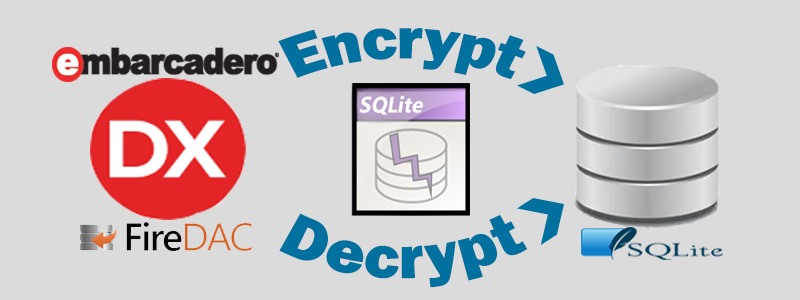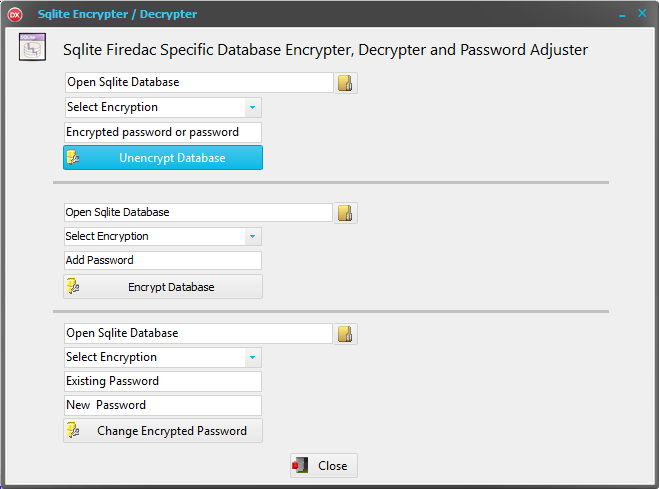Delphi Encrypting and Decrypting Tool for a SQLite Database
The Firedac SQLite component is encryption ready and is totally unique to Delphi . When connecting in encryption mode in your application, the database linking becomes more integrated and once coded, it is better to continue with your encrypted code as it requires a bit of recoding to compile again as a non- encrypted setup.
Here is an example of production styled code used in the Data module for SQLite. The connection definitions use the ‘params’ method to hard code the connection. It allows for the connection to find the database in your development folder when running in Debug mode and then in Non-Debug mode it will look for the Database in the folder where you would deploy it to. As this is Pre- XE5 level coding, it is not targeting mobile ( TPath is not used in this instance) but targeting a Windows X64 and X86 set-up. There are many other options to select such as :- aes-128 ,aes-192, aes-256,aes-ctr-128 ,aes-ctr-192 , aes-ctr-256 ,aes-ecb-128 , aes-ecb-192 , aes-ecb-256.
The following code snippit is based on an AES- 256 database encryption level.
<Code>
type
..
..
function GetDBPath: String;
procedure ConnecttoDB;
procedure DataModuleCreate(Sender: TObject);
private
function DBpath:string;
{ Private declarations }
public
{ Public declarations }
end;
Const DriverID:String = 'SQLite';
SHGFP_TYPE_CURRENT = 0;
var
dm: Tdm;
path: array [0 .. Max_Path - 1] of Char;
implementation
{ %CLASSGROUP 'Vcl.Controls.TControl' }
{$R *.dfm}
procedure TdM.ConnecttoDB;
begin
FDConnection1.Params.Clear;
FDConnection1.Connected := False;
FDConnection1.DriverName := 'sqlite';
FDConnection1.Params.add('DriverID=' + DriverID);
FDConnection1.Params.add('Database= ' + DBpath);
FDConnection1.Params.add('Encrypt = aes-256');
FDConnection1.Params.add('password=aes-256:1234'); //1234 is the encrypted password. Best to use a strong Encryption Key in Production.
FDPhysSQLiteDriverLink1.DriverID := DriverID;
FDSQLiteSecurity1.database := DBpath;
FDSQLiteSecurity1.DriverLink := FDPhysSQLiteDriverLink1;
FDSQLiteSecurity1.Password := 'aes-256:1234';//1234 is the encrypted password
FDConnection1.Params.add('OpenMode = CreateUTF16');
FDConnection1.Params.add('JournalMode = WAL');
FDConnection1.Params.add('LockingMode = Exclusive');//do not want anyone else connecting at same time.
FDConnection1.Params.add('BusyTimeout = 5000');
FDConnection1.Params.add('CacheSize = 10000');
FDConnection1.Params.add('SharedCache = False');
FDConnection1.Params.add('Synchronous = Off');
FDConnection1.Params.add('ForeignKeys = Off');
FDConnection1.Params.add('StringFormat = Choose');
FDConnection1.Params.add('GUIDFormat = String');
FDConnection1.Params.add('DateTimeFormat = String');
FDConnection1.Params.add('Extentions = False');
FDConnection1.Connected := True;
end;
procedure TDM.DataModuleCreate(Sender: TObject);
begin
FDConnection1.connected:=False;
ConnecttoDB;
end;
function TDM.DBpath:string;
begin
{$IFDEF DEBUG}
Result := 'E:\SQLiteCreated.db';
{$ELSE}
if succeeded(ShGetFolderPathW(0, CSIDL_LOCAL_APPDATA, 0, SHGFP_TYPE_CURRENT,
path)) then
Result := path + '\MyGroupAPPFolderName\MyAppName\data\SQLiteCreated.db';
{$ENDIF}
end;
//Other Options
// CCSIDL_COMMON_APPDATA
// CSIDL_APPDATA - individual user Data
// CSIDL_MYDOCUMENTS - mydocs /documents
function TDM.GetDBPath: String;
begin
Result := DBpath;
end;
</Code>
So which is the easiest process available if the database needs some minor changes. It is not as simple as making changes in the database in your tried and tested SQLite Database Tool as you will definitely run into compatibility issues.
I tend to make use of the open source SQLite Database Browser to help me develop SQLite databases quickly without overcomplicating the build. It also requires a non- encrypted Database to make changes. So how do you overcome this?
The easiest solution is to unencrypt your encrypted Database, make the necessary changes in your SQLite Database. Then re-encrypting before re-compiling your Delphi App.
I created a simple Encrypt / Unencrypt and Password Re-name tool using the provided components in Delphi. As I found it useful to me, it would be useful to other developers.
I have provided the source code for both AnyDac ( XE4 to Delphi 7) and FireDac for XE5 and Up . The Source and Binaries are included.
Whilst this application is not complex in design and is easy to create. It just saves a developer from having to go through the trouble to create it. Feel free to modify it to your requirements.
This application uses FDconnection using ‘params’ ,a FDPhysSQLiteDriverLink and a FDsqlitesecurity component.
Below demonstrates some of the code used to create the process of encrypting and unencrypting of a database.
/*
First clear any existing params.
Add the built in SQLite driver. No external dll’s required.
Add the Database.
Select the Encryption level. Many levels are provided as per the documentation.
It uses the ‘FDsqlitesecurity .CheckEncryption’ method to confirm encrypted or unencrypted.
*/
procedure TForm1.Button1Click(Sender: TObject);
begin
FDConnection1.Params.Clear;
FDConnection1.Connected := False;
FDConnection1.Params.add('DriverID=SQLite');
FDConnection1.Params.add('Database=' + edit1.text);
FDPhysSQLiteDriverLink1.DriverID:= 'SQLite';
FDsqlitesecurity1.Database:= edit1.Text;
FDsqlitesecurity1.DriverLink:= FDPhysSQLiteDriverLink1;
if( Combobox2.ItemIndex = 0) or (combobox2.itemindex = 1) then
begin
FDsqlitesecurity1.Password:=edit3.Text;
label3.caption:=edit3.Text;
end
else
begin
label3.caption:=combobox2.Items[combobox2.ItemIndex]+':'+edit3.text;
FDsqlitesecurity1.Password:=combobox2.Items[combobox2.ItemIndex]+':'+edit3.text;
end;
label3.caption:='no password';
FDsqlitesecurity1.removepassword;
FDConnection1.Params.add('Password='+unencryptedpassword);
FDConnection1.Connected := True;
FDsqlitesecurity1.password:= '';
Showmessage('The Encryption level is: '+FDsqlitesecurity1.CheckEncryption);
end;
procedure TForm1.SpeedButton1Click(Sender: TObject);
begin
fileopendialog1.Title:= 'Open SQLite Database File';
edit1.Text:='';
if fileopendialog1.execute then
edit1.text:= fileopendialog1.FileName;
end;
Using this Application makes Decryption an Encrypting a Database quick and painless.
Happy Coding

